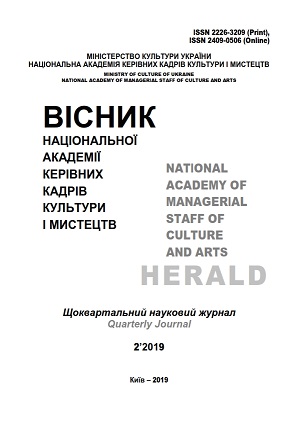Problems of Terminological Unification in the Field of Public Governance by Transboundary Movement of Cultural Values
Problems of Terminological Unification in the Field of Public Governance by Transboundary Movement of Cultural Values
Author(s): Yulia Leonidivna Yurinets, Mark Leonidovych Belkin, Leonid Mikhaylovich BelkinSubject(s): Governance, Public Administration, Politics and law, Politics and society, Culture and social structure , Sociology of Culture, Sociology of Politics
Published by: Національна академія керівних кадрів культури і мистецтв
Keywords: terminology; cultural values; cultural heritage; unification of terminology; transboundary movement of cultural property; collectibles and antiques;
Summary/Abstract: The purpose of the study is to identify terminological inconsistencies and gaps in administrative regulation in the area of transboundary traffic control of cultural values in order to improve public administration in this area while ensuring the rights of citizens. Research methodology. The paper uses methods of documentary analysis and synthesis, comparative analysis, objective truth, which made it possible to trace systematically and compare terminological peculiarities in the sphere of cultural property protection – in Ukraine, on the one hand, in international conventions – on the other hand, and to study judicial practice on the documents of judicial authorities. The method of objective truth is realized by cross-checking of the source data of the research from several sources, relying on judicial practice and digital (statistical) material. The use of these methods contributed to obtaining of our own theoretical and practical results. Scientific novelty consists in formulating and developing the actual topic that has not received a comprehensive scientific coverage before and is investigated for the first time. The efficiency of using the idea of the matrix approach is substantiated in order to provide a systematic comparison of terminological peculiarities of various international and national acts in the sphere of cultural property protection and to find out the best practices of state regulation. Conclusions. Public administration of the cross-border movement of cultural property is an integral part of the state policy in the field of culture and concerns the issues of ensuring the preservation and accessibility of cultural property. Instead, in the legal field, the protection of cultural property does not have the proper terminology. Conflict and incompleteness of the domestic legal regulation in the sphere of export-import of cultural values are established, for example, when comparing the Law of Ukraine «On Export, Import and Return of Cultural Property», on the one hand, and the Ukrainian Classification of Goods for Foreign Economic Activity (UCT FEA), which is guided by international conventions, on the other hand. The lack of the criteria for identifying cultural assets, which should be protected creates a situation of legal uncertainty in the transportation of certain types of values across borders that violate the rights of citizens.
Journal: Вісник Національної академії керівних кадрів культури і мистецтв
- Issue Year: 2019
- Issue No: 2
- Page Range: 145-151
- Page Count: 7
- Language: English

